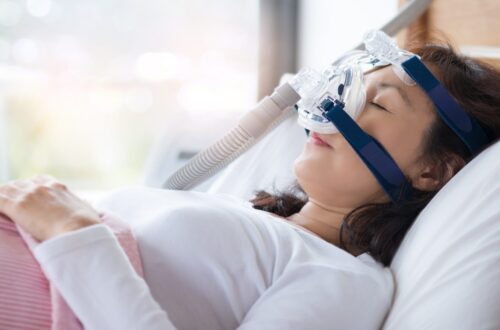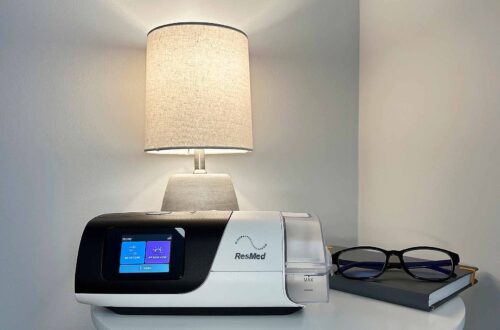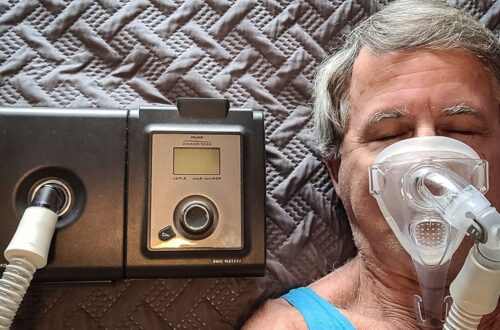
Tips for Adjusting to Life with a CPAP Mask
Adjusting to life with a CPAP mask can be challenging, but with the right tips and techniques, you can ease the transition and experience the benefits of this life-changing device. In this article, we will provide you with valuable insights into understanding the importance of a CPAP mask, getting acquainted with your CPAP mask, overcoming common CPAP challenges, integrating CPAP into your nightly routine, and maintaining your CPAP equipment.
Understanding the Importance of a CPAP Mask
Before delving into the tips for adjusting to life with a CPAP mask, it’s essential to understand its significance in sleep apnea treatment. Sleep apnea is a sleep disorder characterized by pauses in breathing or shallow breaths during sleep. CPAP, which stands for Continuous Positive Airway Pressure, is a therapy that uses mild air pressure to keep the airways open, preventing breathing interruptions that occur due to sleep apnea.
By delivering a continuous flow of air through a mask worn over the nose or mouth, CPAP helps maintain a steady breathing pattern, ensuring uninterrupted sleep. This plays a crucial role in improving sleep quality and reducing the risk of associated health problems.
The Role of CPAP in Sleep Apnea Treatment
Sleep apnea can significantly impact your quality of life and overall health. Untreated sleep apnea may lead to daytime fatigue, morning headaches, difficulty concentrating, and even cardiovascular issues. CPAP therapy has proven to be a highly effective non-invasive treatment for sleep apnea, providing relief from symptoms and improving overall well-being.
CPAP works by creating a constant flow of air pressure, which acts as a splint to keep the airways open. This prevents the collapse of the throat muscles that cause sleep apnea episodes. By ensuring a continuous supply of oxygen, CPAP therapy helps reduce the strain on the heart and lungs, improving cardiovascular health.
Furthermore, CPAP therapy has been shown to alleviate symptoms such as loud snoring and restless sleep, allowing both the user and their sleep partner to enjoy a peaceful night’s rest. This can have a positive impact on relationships and overall quality of life.
Health Benefits of Regular CPAP Use
Regular use of a CPAP mask brings forth numerous health benefits. By ensuring adequate oxygen supply during sleep, CPAP helps reduce the risk of heart disease, stroke, and high blood pressure. Sleep apnea has been linked to an increased risk of cardiovascular problems, and CPAP therapy addresses this concern by maintaining normal breathing patterns throughout the night.
Moreover, CPAP therapy can alleviate symptoms of excessive daytime sleepiness, a common consequence of sleep apnea. By providing a restful night’s sleep, CPAP allows individuals to wake up feeling refreshed and energized, improving their ability to concentrate and perform daily tasks.
In addition to the physical health benefits, CPAP therapy also plays a crucial role in reducing the risk of accidents caused by drowsiness throughout the day. By promoting better sleep quality, CPAP helps individuals stay alert and focused, enhancing overall safety and quality of life.
It’s important to note that CPAP therapy is not a cure for sleep apnea but rather a management tool. Consistent and regular use of the CPAP mask is essential for optimal results. Adapting to life with a CPAP mask may take time and patience, but the long-term benefits are well worth the effort.
In conclusion, the CPAP mask is a vital component of sleep apnea treatment, offering numerous health benefits and improving overall well-being. By understanding the significance of CPAP therapy and its role in maintaining normal breathing patterns during sleep, individuals can embrace the mask as a valuable tool in their journey towards better sleep and a healthier life.
Getting Acquainted with Your CPAP Mask
Now, let’s explore some tips to help you get acquainted with your CPAP mask. Familiarizing yourself with CPAP components and learning how to properly fit your mask are key steps to ensure effective and comfortable therapy.
Familiarizing Yourself with CPAP Components
A CPAP mask consists of various components, including the mask itself, headgear, tubing, and a machine that delivers the pressurized air. Each component plays a vital role in delivering the therapy you need to improve your sleep apnea symptoms. Let’s dive deeper into each component:
The mask: This is the part of the CPAP system that fits over your nose or mouth, depending on the type of mask you have. It creates a seal to prevent air leaks and ensures that the pressurized air reaches your airways effectively. There are different styles and sizes available, so it’s important to find the one that suits you best.

Headgear: The headgear is responsible for securing the mask in place while you sleep. It should be adjustable to achieve a secure yet comfortable fit. The straps should not be too tight, as this can cause discomfort, but they should also not be too loose, as it may lead to air leaks. Take the time to adjust the headgear properly to ensure a snug fit.
Tubing: The tubing connects the mask to the CPAP machine, allowing the pressurized air to flow from the machine to your airways. It’s important to keep the tubing clean and free from any obstructions to ensure optimal therapy. Regularly inspect the tubing for any signs of wear and tear, and replace it if necessary.
CPAP machine: This is the heart of the CPAP system. It delivers the pressurized air that keeps your airways open during sleep. The machine should be placed on a stable surface near your bed, and the settings should be adjusted according to your prescribed pressure. Familiarize yourself with the controls and functions of the machine to ensure proper usage.
Read the instruction manual thoroughly to understand how each component works together to provide optimal therapy. If you have any questions or need clarifications, don’t hesitate to reach out to your healthcare provider or CPAP supplier. They are there to support you on your journey to better sleep. You can also read about Note this about different CPAP masks by visiting https://supplementsforskinhealth.com/note-this-about-different-cpap-masks/
How to Properly Fit Your CPAP Mask
Proper fitting is crucial to ensure an effective and comfortable CPAP experience. When your mask fits well, it minimizes air leaks and maximizes the effectiveness of the therapy. Here are some steps to help you achieve the perfect fit:
Adjust the headgear straps: Start by adjusting the headgear straps to achieve a secure yet comfortable fit. The straps should be snug but not too tight. It’s important to find the right balance to avoid discomfort and pressure marks. Take your time to adjust the straps until you find the perfect fit.
Create a seal: The mask should create a seal over your nose or mouth, depending on the type of mask you have. This seal ensures that the pressurized air is delivered effectively to your airways. If you notice any air leaks, adjust the straps or try a different size or style of mask. It may take some trial and error to find the mask that fits you perfectly.
Seek professional guidance: If you’re having difficulty finding the perfect fit or if you’re unsure about the size or style of mask that suits you best, don’t hesitate to seek professional guidance. Your healthcare provider or CPAP supplier can help you select and fit your CPAP mask properly. They have the knowledge and expertise to guide you through the process and ensure that you get the most out of your therapy.
Remember, finding the right CPAP mask and achieving a proper fit is essential for effective and comfortable therapy. Don’t hesitate to reach out for help and support along the way. Your journey to better sleep starts with a well-fitted CPAP mask.
Overcoming Common CPAP Challenges
While adjusting to life with a CPAP mask, you may encounter common challenges that can be overcome with the right strategies and support.
Dealing with Initial Discomfort
It’s common to experience initial discomfort when first using a CPAP mask. This discomfort may arise from the sensation of wearing a mask, feeling confined, or struggling to sleep in a new position. To overcome this, gradually increase your usage time, starting with short periods during the day, and gradually progressing to wearing the mask throughout the night. This allows your body to adjust to the mask’s presence, making it more comfortable to wear as you sleep.
Managing Common Side Effects
Some users may experience side effects such as dry mouth, nasal congestion, or skin irritation. To manage dry mouth, try using a heated humidifier that adds moisture to the air delivered by the CPAP machine. Nasal congestion can be alleviated by using saline nasal sprays or nasal rinses before bed. If skin irritation occurs, ensure that your mask is clean and properly fitted. Using moisturizers or barrier creams can also help protect your skin from irritation.
Tips for Integrating CPAP into Your Nightly Routine
For successful CPAP therapy, it’s essential to integrate it into your nightly routine seamlessly. Creating a comfortable sleep environment and establishing a pre-sleep routine can greatly enhance the effectiveness and adherence to CPAP therapy.
Creating a Comfortable Sleep Environment
Your sleep environment plays a vital role in ensuring a restful night’s sleep. Keep your bedroom cool, dark, and free from distractions. Invest in a comfortable mattress and pillows to enhance overall comfort and support. Additionally, consider using white noise machines or earplugs to drown out any sounds that may disrupt your sleep.
Establishing a Pre-Sleep Routine
Establishing a pre-sleep routine can signal your body that it’s time to wind down and prepare for sleep. Engage in relaxing activities such as reading a book, practicing deep breathing exercises, or taking a warm bath. Avoid exposure to bright screens or stimulating activities close to bedtime, as they can interfere with your ability to fall asleep.
Maintaining Your CPAP Equipment
Maintaining your CPAP equipment is crucial for its longevity and effective performance. Regular cleaning and timely replacement of parts ensure optimal therapy and prevent the accumulation of bacteria or allergens. Click here to read about Health Conditions Prevalence.
Daily and Weekly Cleaning Tips
Clean your CPAP mask, headgear, and tubing daily using mild soapy water or a CPAP mask cleaner. Ensure all components are thoroughly dried before assembly. Weekly, sanitize your CPAP machine using a manufacturer-approved CPAP cleaner or a combination of vinegar and water. Follow the manufacturer’s guidelines for specific cleaning instructions to avoid damaging your equipment.
When to Replace CPAP Parts
CPAP parts, such as cushions or filters, may require replacement over time. Inspect your equipment regularly and replace any worn-out or damaged parts. Consult your equipment manual or reach out to your CPAP supplier to determine the recommended replacement schedule for your specific equipment.
Conclusion
Adjusting to life with a CPAP mask may require patience and perseverance, but the benefits of effective sleep apnea treatment are well worth the effort. By understanding the importance of a CPAP mask, getting acquainted with your equipment, overcoming challenges, integrating CPAP into your nightly routine, and maintaining your CPAP equipment, you can successfully adapt to the CPAP therapy and experience improved quality of sleep and overall well-being.





